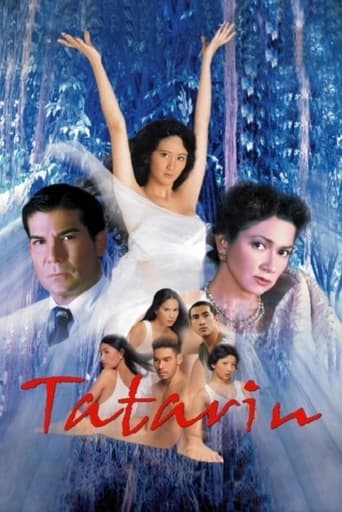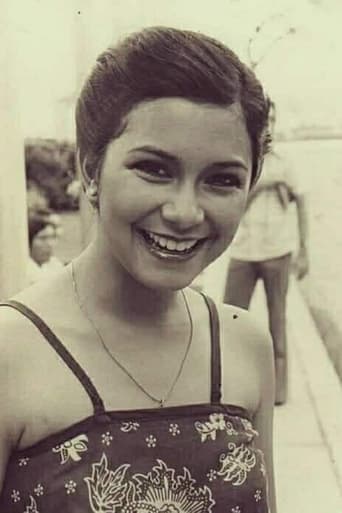

Tatarin (2001)
A ritual performed by women to invoke the gods to grant the blessing of fertility by dancing around a Balete tree that was already a century old.
Watch Trailer
Cast


Reviews
Although it has its amusing moments, in eneral the plot does not convince.
If the ambition is to provide two hours of instantly forgettable, popcorn-munching escapism, it succeeds.
This is a coming of age storyline that you've seen in one form or another for decades. It takes a truly unique voice to make yet another one worth watching.
It’s not bad or unwatchable but despite the amplitude of the spectacle, the end result is underwhelming.
Before anything else, it should be made clear that this review was made comparing the film to the original text which it was based on. The Summer Solstice, a short narrative by Nick Joaquin is genius and powerful, clearly a timeless masterpiece inspired by the greatest of muses. But sad to say, the film adaptation of the short story entitled, Tatarin is seriously lacking in depth and quality which makes it easily forgettable. From unforgettable to forgettable. This was how much the film adaptation ruined the narrative. Nick Joaquin's story was effective in portraying a eulogy to a man-driven, pseudo-American Philippine society, while its film adaptation directed by Amable Aguiliz was confusing. Despite being backed by Viva Films, one of the major production machines to ever grace Philippine cinema, the film still succeeds to end up a miserable undertaking, light years away from being a timeless classic that Nick Joaquin's story is. Tatarin was an entry to the 2001 Metro Manila Film Festival but to my knowledge it failed to bag a major award in the event. And rightfully so. For starters, the film was filled with a roster of newcomers to the silver screen, most of them were sexy stars. I have nothing against neophyte actors, actresses or sexy stars but putting them in a material possessing enormous potential was not a very good idea as proved by the finished product. Much of the film's lackluster acting should be attributed to them. I think the producers and the director should have chosen from a pool of seasoned actors and actresses in the country. But then again, choosing an actor also depends on the roles available. The scriptwriters and the director added and modified some characters from the original text which made it difficult to cast veterans. One such example can be seen in the Moretas' house aids. In the original text, Amada was not a young vixen that Rica Paralejo is. Then again, the director and his crew always have the freedom to modify the original narrative whenever they deem it necessary. It is only an adaptation after all. Of course the next question would be: was the particular change necessary? This is where it gets tricky and contentious. This also serves as an argument supporting my comparison of the short story and its adaptation.I really do not think that transforming Amada and the rest of the Moretas' house helpers into sexy, young, erection inspirations was done to better the original text. If someone watches the film without reading the text and sees the scene wherein Guido asks Lupeng about Amada, he or she would likely think that it is only natural for Guido or any man to be enchanted by Amada since she was portrayed by a woman in her mid-twenties with a voluptuous body. But credit should also be given to the fact that Amada was a Tadtarin that day. This is what I mean when I say that the film adaptation was confusing. On the other hand, Amada as written in The Summer Solstice was stout and elderly. Thus when Guido asks Lupeng about her it was clearer that her enthralling appeal was because she was a Tadtarin. Why then was Amada modified for the adaptation? An endless number of answers or opinions might surface but I feel that this has something to do with the cast of breast-baring sexy stars who comprise much of the Moretas' household. The film was not made for art's sake. It was made to sell. And the moderate sexual content included in the film, enough to garner it a R-18 rating by the way, proves just how much it depends on sex to sell tickets.
There are at least three entries in the 2001 Metro Manila Film Festival that seem meant to be taken as actual quality fare: Tikoy Aguiluz's "Tatarin" (Summer Solstice); Joel Lamangan's "Hubog" (A Woman's Curve), and Marilou Diaz Abaya's "Bagong Buwan" (The New Moon).The standout by far among the three, I think, is Tikoy Aguiluz's "Tatarin." Based on Nick Joaquin's play "Summer Solstice," the film is about the oldest and longest-running war known to man, the war between the sexes. Joaquin's problem then was how to make this war relevant again to jaded audiences (the play was written in 1975); his solution was to set the play in the 1920s, when male-dominated Western Culture was just beginning to tremble. Aguiluz's adoption of Joaquin's stratagem is, I think, a smart move--this way he captures the very roots of the war (or at least of the 20th century edition of the war) as waged by our grandparents and great-grandparents; he photographs the combatants at a time when the battle is still urgent and raw, the stakes desperately high.And the battle lines are drawn, of course, around a married coupleDon Paeng and Dona Lupe Moreta (Edu Manzano and Dina Bonnevie), on the evening of the Feast Day of St. John the Baptist, on the third night of the "Tatarin"--a pagan ritual where for three days out of the year women hold ascendancy over men.I can't think of a better Filipino filmmaker than Aguiluz to evoke the living past--especially in a production like this, where immersion in a long-gone age is crucial to the success of the film. Combining the considerable resources of Viva Studios (which are usually poured into banal glamour productions) with his keen documentary filmmaker's eye, Aguiluz (with the help of production designer Dez Bautista) evokes the remarkably authentic, miraculously detailed world of the Moretas--from the flour mill that produces their dried noodles, to the 1920s-style kitchen hard at work on dinner, to the luxuriously appointed family mansions with their incredible painted ceilings. And it's not just a matter of having an enormous production budget; it's the intelligence to pick out this particular detail, the wit to shoot from that particular angle--then the judiciousness to cut it all up so that you only glance at the images, and are left wanting more.But more than the ability to recreate a historical period, Aguiluz (again, with the help of writer Ricky Lee and editor Mirana Medina) is able to streamline Joaquin's play, to focus on the struggle between Don Paeng and Dona Lupe. The three have tinkered with Joaquin's married couple, made delicate adjustments, crucial revisions--the Moretas, for one, have lost all warmth and affection for each other, where in the play they still show signs of tenderness. Don Paeng has become a psychologically immobile, sexually impotent monster (kudos to Edu Manzano for the courage to portray such a thoroughly unlikable man) while Dona Lupe (Dina Bonnevie, in possibly the performance of her career) has become more submissive, more withdrawn (the better to highlight the climactic reversal when it comes).Then there is the dialogue, which has been pruned, made less explicit, made more functional than decorative. Besides the careful pruning, Aguiluz manages to locate the drama in the moments when words are not spoken--through shots that encapsulate in a single image the tension of the scene, like the one where Dona Lupe's foot is kissed by Guido (Carlos Morales), with Don Paeng watching from the balcony. Don Paeng, the shot says to us, is ascendant by virtue of his standing in the balcony, but is also rendered remote and helpless by the distance.Then the "Tatarin" ritual itself. Moved offstage in the play, the ritual occupies center stage in the film: a wordless, ten-minute orgy of pulsing drumbeat, flaring torches and convulsing women. Aguiluz wanted the sense of a real location turned theater set, and he got it--the dance, staged at the foot of an actual balete tree, feels nightmarish, surreal. And obscene--though nudity is at a minimum, there is no lack of lewdness to the drumming and dancing, which at times is reduced to frank rutting. "Pagan" is a polite and inadequate term for what happens at the foot of the balete tree."Tatarin" feels more lighthearted than Aguiluz's earlier works, if only because he doesn't end the film with a life-or-death situation (meaning: the protagonist didn't die). More, it's the first really comic film Aguiluz has ever directed, and he handles the material with admirable lightness and vigor. One of the best Filipino films of the year, and my vote for best of the festival, hands down.
The masterpiece of National Artist Nick Joaquin, the "Tatarin" is a depiction of the 20s. It presented the ancient pagan dance ritual, known as the "Tatarin" itself, which is celebrated on the same day coinciding the feast of St. John the Baptist. It started out in a period of play production but with the technology of cinema, it has been turned into a motion picture by a great director namely Tikoy Aguiluz and had been scripted by Ricky Lee for Viva Films. Another National Artist namely Lucresia Kasilag (for music) composed the music. Edna Vida of Ballet Philippines choreographed the dance rituals and Dez Bautista was tapped as production designer for the period setting. Well, I had to pay attention to these bits of information anyway. I just watched the film in order to make a movie review again and the text here is what I passed to my professor. I am not going to watch a bold film anyway if I am not required to."Tatarin" used the backdrop of the American occupation, the period where the picturesque "Tatarin" ritual awakens the goddesses in the quiet, passive spirits of a mistress of a mansion, Lupe (Dina Bonnevie) and her maid Amada (Rica Peralejo). Drawn to worship of a centuries-old Balete tree, Lupe and Amada are caught in a trance that liberates them from all their inhibitions. Through ceaseless chanting, Lupe and Amada empower the weakest of their sensibilities. And by some form of erotic pagan dance, they rouse to frenzy the most savage of their desires that from long ago, had been chained up to frigidity by men who dominate their world. There is a distinction between the male and the female sexuality then in this film that has been shown. Also, there was the ritual of water. This is done by literally wetting people, even if they are just walking on the road. During the 20s-40s, this ritual has a little sexually related meaning giving stimulation to the watching males on the females in the procession. These females were the ones who were subject to the "Tatarin-soul transfer." They join the procession of the males that attracts them but the females later go back to a hidden place where they started doing their dancing accompanied by their hallucinations and desires. In the evening, they go back to their husbands and prefer doing sex.The film is a little "libidinous" in a more complex sense than what merely culminates in bed, or any other explosive location-to go by movies these days, the bed is now the least preferred one. Lupe and Paeng (Edu Manzano) is a 1920s couple straddling two worlds, the worlds of dark and light, sun and moon, day and night. It takes place during the time when the world is equally divided into day and night hence, the title. It is also a time when the sun boils at day and the moon burns at night, which makes for oppressive heat. The characters in the story keep talking about that heat, which gives it all sorts of resonance and males still dominate over females. Beyond the literal, Lupe and Paeng straddle the worlds of a Catholic present and a pagan past, a present that exalts manhood and a past that worships womanhood, a world of rules and convention and a world of instinct and primal drives. This shows the setting of Nick Joaquin's story then.On the day of the Tatarin, all their dreams are believed to come true. Mothers without kids, a girl wishing her unfaithful mate to come back, an old lady wanting to restore her beauty, and a woman dreaming of the man she loves all of them pray and wish and offer sacrifices for the Tatarin. And coinciding with the Feast of St. John, females are unstoppable. She dances the power of a woman - the meaning of the Tatarin like a knife of a butcher; this is a weapon of women against men. The aim of the women is to make all men follow what they desire. (The moon as the queen of the females - ruling the night and covering the day.) If you try to stop them, a plague will somehow rule the land.Lupe's descent-or ascent-from the first to the second, a tilting of the weight from the one to the other restores balance between heaven and earth. This happens during the Tatarin, the Philippine version of a druidic festival or rite, which itself fuses two seemingly contradictory worlds. The Tatarin, a pagan festival, culminates on the feast of St. John, who is not just a definitely Christian symbol but also a thoroughly masculine one. In the end, Paeng, the master, pleads in the dust before his wife, ready to kiss her feet and become submissive. One line justifies it and it goes: The moon becomes as bright .............. as the sun.
Maybe lot of Filipino viewers hate Edu Manzano with his sadistic hosting of the Philippine's version of The Weakest Link that's why this movie flop! It's Edu Manzano's first movie since hosting the localized version of the Weakest Link where he insulted more than a hundred of participants. The trailer of this movie, with an authorized usage of Drowning Pool's Bodies as background, was heavily rotated during The Weakest Link hour at IBC-13.This movie could be the WEAKEST among the entries in the 2001 Metro Manila Film Festival, despite it's a Viva Films production. With Dina Bonnevie, Rica Peralejo and lot of sexy stars in the cast, the movie could have been the top crowd-drawer among the male adult viewers. But sad to say, the movie was a loser when it was shown. I could not remember that this movie got any award in the 2001 MMFF. Edu was humbled by Cesar Montano, Dina was a peanut to a newcomer named Assunta de Rossi, a bold actress. This could be a classic since it was based on a Nick Joaquin's novel and directed by Tikoy Aguiluz. But there's nothing here that can qualify this movie as a soon-to-be classic. Ms. Peralejo's breast exposure was nothing. Ms. Bonnevie was too old to do a sexy role. Ms. Taylor's timid acting was a waste. Ms. Jaca's role is forgettable. In short, this movie is a trash.




